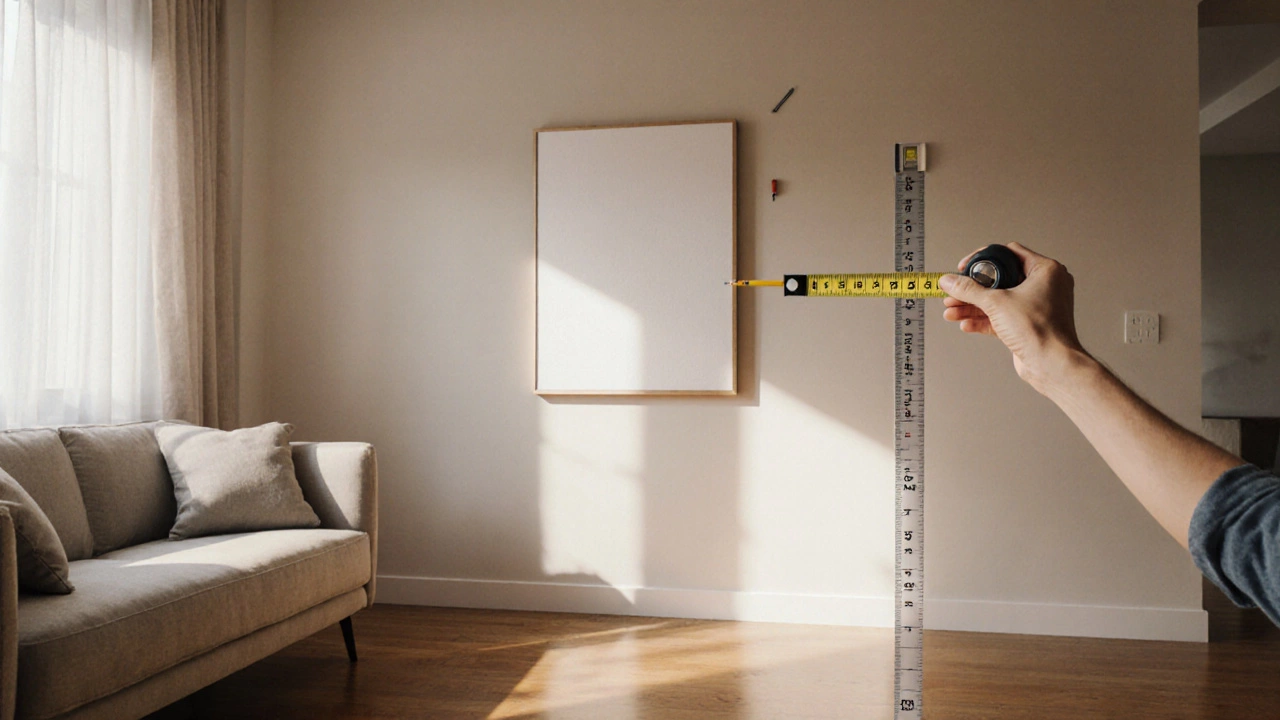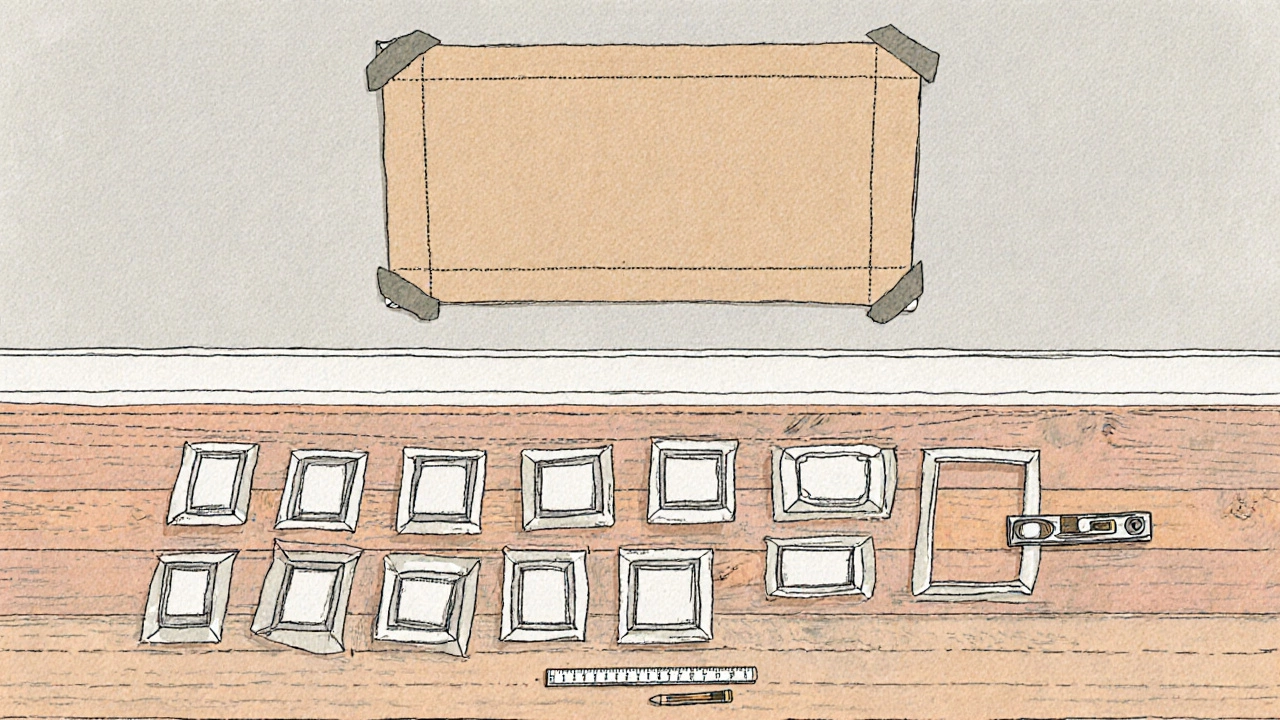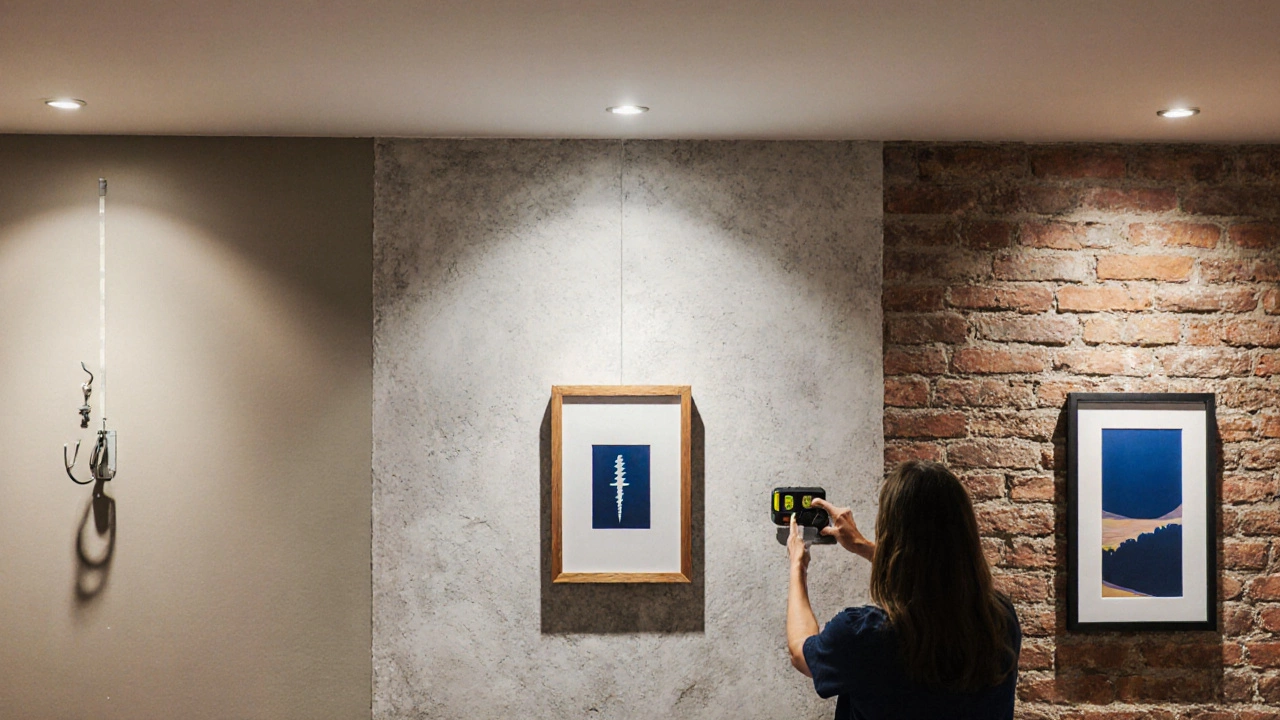Picture Hanging Rules: How to Hang Art at the Perfect Height

Picture Hanging Height Calculator
Hanging Height Recommendation
Key Measurements Guide
- Standard Eye Level 57 inches
- High Ceiling Adjustment 2/3 wall height
- Gallery Wall Spacing 2-4 inches
Quick Takeaways
- Most experts recommend the center of the artwork at 57‑inches (about 145cm) from the floor - the traditional gallery height.
- If the room’s ceiling is higher than 9ft, shift the center up to 2/3 of the wall height for better proportion.
- For a gallery wall, keep a 2‑inch (5cm) gap between frames of the same size; increase to 3‑4inches for mixed sizes.
- Use a picture hook rated for the frame’s weight and secure it into a stud or wall anchor.
- Always level your art with a small bubble level or a laser level before finalizing the nail.
What the "Picture Hanging Rule" Actually Means
When you hear people talk about the picture hanging rule is a set of simple measurements that help you place artwork so it feels balanced in a room, they’re really referring to eye‑level positioning. The classic guideline puts the picture’s center at about 57inches (145cm) from the floor - the height most museums use for their collections. This rule works because it aligns the artwork with the average viewer’s eye line, making the piece easy to view without tilting the head up or down.
Why 57inches? Studies of gallery visitors show that this height catches the eye while keeping the surrounding space comfortable. It’s not a law, but a reliable starting point you can tweak based on ceiling height, furniture layout, or personal taste.

Measuring for a Single Piece
- Find the eye level - for most adults it’s around 57‑inches from the floor.
- Measure the height of your frame. Divide that number by two to get the center of the wall for that piece.
- Add the half‑frame height to the eye‑level measurement. Example: a 24‑inch tall canvas → 12inches + 57inches = 69inches. That’s where the top of the frame should sit.
- Mark the spot with a pencil, double‑check with a level tool, and drill a pilot hole.
- Insert a picture hook that matches the frame’s weight (see hardware section).
Tip: If you have a high ceiling (over 9ft), move the center up to roughly two‑thirds of the wall height. That prevents the art from looking stuck in the lower third.
Arranging Multiple Frames - The Gallery Wall Formula
When you want a cluster of pictures, the same eye‑level principle applies, but you also need consistent spacing.
- Uniform size: keep a 2‑inch gap between each frame. This creates a neat, block‑like appearance.
- Mixed sizes: increase the gap to 3‑4inches for visual breathing room.
- Horizontal vs. vertical: start by laying frames on the floor, aligning the tops, then measure the overall width. Center the entire arrangement on the wall using the 57‑inch rule for the central piece.
To avoid a “wonky” look, use a piece of cardboard cut to the total dimensions of your layout, tape it to the wall, and step back to judge the balance before drilling.
Choosing the Right Hardware
Not every picture hook is created equal. Follow these steps:
- Check the frame’s weight - most manufacturers list this on the back. If not, weigh the frame on a kitchen scale.
- Match the hook’s weight rating to be at least 20% higher than the frame’s weight. For a 5‑lb frame, use a hook rated for 6‑7lb.
- Identify the wall type. Drywall, plaster, concrete, and brick all need different anchors.
- For drywall, a simple picture hook works if you’re hitting a stud. Use a stud finder to locate the stud; otherwise, opt for a plastic toggle or molly bolt.
- For plaster or brick, use a heavy‑duty anchor and a drill with the appropriate bit.
Always test the hook by pulling gently before hanging the art - a secure anchor won’t wobble.

Adjusting for Wall Materials and Weight
| Wall Type | Max Frame Weight (lb) | Recommended Fastener |
|---|---|---|
| Drywall - stud | 20+ | Heavy‑duty screw‑in hook |
| Drywall - no stud | d>5‑10Toggle bolt or molly anchor | |
| Plaster | 10‑15 | Concrete screw with wall plug |
| Brick / Concrete | 25+ | Lead‑filled anchor with masonry bit |
Heavier pieces (mirrors, large canvases) often need two hooks spaced evenly on the back. Measure the distance between the hooks, replicate that spacing on the wall, and ensure both anchors are level.
Common Mistakes & Pro Tips
- Wrong height: Relying on a single furniture piece (like a sofa) can mislead. Always start with the 57‑inch benchmark.
- Ignoring wall texture: Rough plaster can cause anchors to loosen. Tap lightly first to feel resistance.
- Skipping the level: Even a half‑inch tilt looks sloppy once the piece is up. Use a bubble level or a laser level for precision.
- Overloading a single hook: Split weight across two hooks for frames over 10lb.
- Not accounting for future changes: If you plan to rearrange, use removable command strips for lightweight art; they leave no holes.
Pro tip: After hanging, step back to the opposite side of the room. Your eye will catch any off‑center placement faster than when you’re standing right in front.
Frequently Asked Questions
What height should I use for a picture above a couch?
Place the artwork’s center about 6‑8inches above the couch’s backrest. Then use the 57‑inch rule for the overall wall to keep the room’s flow balanced.
Can I hang a heavy mirror without a stud?
Yes, but you’ll need a strong masonry anchor or toggle bolt rated at least 1.5 times the mirror’s weight. For very large mirrors, consider a French cleat system that distributes load across a larger area.
Is 57 inches still relevant for modern homes with higher ceilings?
It’s a solid baseline, but when ceilings exceed 9ft, move the center up to roughly two‑thirds of the wall height. This keeps the art from looking lost in the upper third.
How do I avoid damaging drywall when I remove a hook?
Use a small screwdriver to gently pry the anchor out. If the hole is large, fill it with spackle, sand smooth, and repaint.
What’s the best way to keep a gallery wall level?
Lay a large piece of cardboard on the floor, arrange the frames inside it, then tape the cardboard to the wall. Use a level along the top edge of the cardboard to ensure it’s straight before drilling.